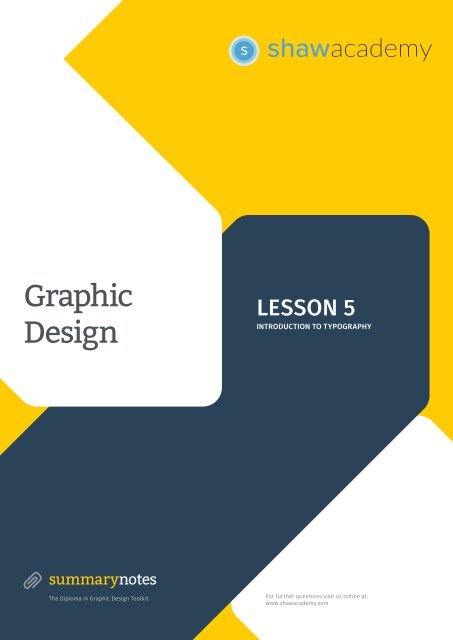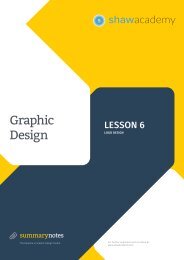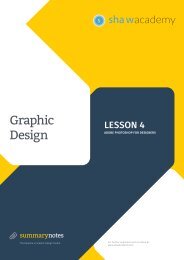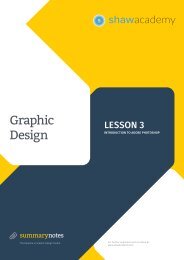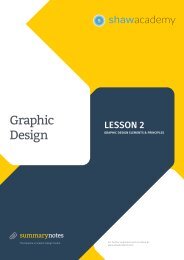Create successful ePaper yourself
Turn your PDF publications into a flip-book with our unique Google optimized e-Paper software.
S<br />
shawacademy<br />
Graphic<br />
Design<br />
LESSON 5<br />
INTRODUCTION TO TYPOGRAPHY<br />
summarynotes<br />
The Diploma in Graphic Design <strong>Toolkit</strong><br />
For further questions visit us online at:<br />
www.shawacademy.com
S <strong>Lesson</strong> 5<br />
S<br />
shawacademy
S <strong>Lesson</strong> 5<br />
WE BEGIN WITH THE<br />
“WHAT IS” OF GRAPHIC<br />
DESIGN AND HOW<br />
GRAPHIC DESIGN IS ALL<br />
ABOUT VISUALLY COM-<br />
MUNICATING AN IDEA,<br />
THOUGHT, MESSAGE OR<br />
MEANING BY COMBINING<br />
SYMBOLS, IMAGES AND/<br />
OR WORDS. WE ALSO<br />
GIVE AN OVERVIEW OF<br />
THE “HOLY TRINITY”<br />
OF GRAPHIC DESIGN<br />
APPLICATIONS -<br />
ADOBE PHOTOSHOP,<br />
ILLUSTRATOR &<br />
INDESIGN AND HOW<br />
DESIGNERS BEST USE<br />
THESE TOOLS.<br />
1.01 What Is Typography 4<br />
1.02 Typefaces v Fonts 6<br />
1.03 Text Type v Display Type 8<br />
1.04 Basic Forms 10<br />
1.05 Classifications & Timeline 12<br />
1.06 Anatomy, Size & Measure 13<br />
1.07 Kerning, Tracking,<br />
Leading & Measure 14<br />
1.08 Combining Type 16
S<br />
What is Typography?<br />
Typography<br />
is, quite<br />
simply,<br />
the art and<br />
technique<br />
of arranging<br />
type.
S<br />
What is Typography?<br />
Graphic Design is<br />
“the art or<br />
profession of visual<br />
communication that<br />
combines images,<br />
words and ideas to<br />
convey information<br />
to an audience”<br />
Typography is an art form that has been around for<br />
hundreds of years.<br />
Words and text are all around us every day in<br />
almost everything we do.<br />
In every piece of type you see, somebody has<br />
considered how the letters, sentences and<br />
paragraphs will look in order for it to be read by us,<br />
or make us feel a certain way when we look at it.<br />
Sometimes it is done well, others not.<br />
Often it is us graphic designers who are the ones<br />
deciding how it will look, in our brochures, our<br />
logos, our websites and so on.<br />
The better we are at this, the more effective our<br />
designs will be.<br />
Design must<br />
be interpreted<br />
the same way<br />
by everyone<br />
to function.<br />
WHY TYPOGRAPHY IS IMPORTANT<br />
And as we all know by now Graphic Design is all<br />
about conveying a message.<br />
With regard to colour and shape, type also plays a<br />
role in the impression of your message.<br />
It gives the viewer an impression before even<br />
reading it.<br />
It can appear friendly or aggressive, suggest a<br />
traditional or modern approach, can look feminine<br />
or masculine, it can look chaotic or calm. So it’s your<br />
job to choose a type style that best expresses your<br />
message.<br />
Type has a personality and makes an impression. In<br />
the same way as colour and shape it can evoke an<br />
emotional response. Good type makes a difference!
S<br />
Typefaces v Fonts<br />
“A font is what<br />
you use, and<br />
typeface is what<br />
you see.”
S<br />
Typefaces v Fonts<br />
1.02<br />
Typefaces v Fonts<br />
Typeface<br />
Franklin Gothic Book<br />
{<br />
Franklin Gothic Medium<br />
Franklin Gothic Demi<br />
Franklin Gothic Heavy<br />
Franklin Gothic Medium Condensed<br />
Franklin Gothic Demi Condensed<br />
{<br />
Font<br />
Franklin Gothic Book<br />
A typeface is a family of fonts (such as the Franklin<br />
Gothic Typeface here, Helvetica Regular, Helvetica Italic,<br />
Helvetica Bold, Helvetica Black, etc. would be another.)<br />
But a font is one weight or style within a typeface family<br />
(such as Franklin Gothic Book).
S<br />
Text Type v Display Type<br />
Some of the most<br />
popular typefaces<br />
still in use today<br />
have been around<br />
for hundreds of<br />
years, because<br />
they still work.<br />
(Adobe CalsonPro,<br />
Baskerville, Adobe<br />
Garamond Pro)
S<br />
Text Type v Display Type<br />
1.03<br />
Text Type v Display Type<br />
Text Type<br />
Text Type, usually between 8 –10 points, is designed to be used<br />
in large quantities at small sizes, for example most of newspaper<br />
and magazine type is Text Type.<br />
It has to be easy to read. Smooth reading is the goal and should<br />
seem as effortless as possible when we are reading. Again good<br />
typography should nearly go unnoticed.<br />
Text Types share some common characteristics to aid the clarity<br />
and smooth readability.<br />
• Open Spaces<br />
• Tall Body Type in comparison to the Capitals<br />
• Rhythmic Repetitive Shapes<br />
• Medium Weight<br />
Display Type<br />
Display Type is usually 14 point or larger and is used in small<br />
quantities for emphasis and effect.Display Type is designed to be<br />
noticed. There is a vast number available for every possible use from<br />
Handwriting to Space Age! Text Type can function as Display Type,<br />
but not the other way around.<br />
Display Type is like the icing on your<br />
cake when it comes to design.
S<br />
Basic Forms<br />
There are many<br />
different classifications<br />
and<br />
sub-classification<br />
of typefaces, but<br />
the most common<br />
two types you will<br />
hear of are:<br />
Serif & Sans-serif
S<br />
Basic Forms<br />
1.04<br />
Basic Forms<br />
Serif Sans Serif Slab Serif Script Monospace Blackletter Display<br />
Serif – these typefaces are the<br />
more traditional ones. They are<br />
distinguished by a short line or<br />
finishing stroke on the end of<br />
character strokes and stems.<br />
Serifs are evident in both capital<br />
and lowercase letters. The angles<br />
of the Serifs can vary. Their<br />
thickness and width can also vary.<br />
These may be small details but this<br />
all matters when it is set in a size<br />
suitable for reading.<br />
Slab Serif - A Sub-Category of Serif are what are called<br />
Slab Serifs, and they are exactly what they sound like. The<br />
difference is their Horizontal strokes are the same width as<br />
their Vertical strokes.<br />
Script - Based on handwritten letters. Mostly or partly<br />
attached. Can be formal or informal (handwritten,<br />
brush). Can be tricky to use because of large swashes.<br />
Monospace - The letters each measure equidistant horizontally.<br />
They were first created for typewriters, where each<br />
letter’s spacing had to be identical.<br />
Sans Serif – as the name<br />
suggests, these are distinguished<br />
by their lack of any Serifs.<br />
They only became popular in<br />
the nineteenth century and are<br />
considered modern as a result.<br />
Blackletter / Fraktur - Look fractured or broken<br />
because each letter is made up of individual strokes. Tend<br />
to be heavy in appearance, hence the name! Often called<br />
Old English. Small spaces within and between letters, and<br />
tight spacing between the lines. Overall colour on the page is<br />
heavy or black.<br />
They have no Feet. By their<br />
meaning “Sans” means without in<br />
French.<br />
Display - Display fonts have a huge variety, these are the<br />
fonts you should use when you want to make an impact.<br />
Good for capturing user’s attention. These should not be<br />
used for body copy as the generally need to be a large size<br />
for readability.
Classifications & Timeline<br />
SERIF<br />
OLDSTYLE (15th – 18th Century)<br />
– Calson, Sabon, Bembo, Garamond<br />
Low contrast between thick and thin strokes. Thick Bracketed Serifs. Long<br />
senders and descenders, the parts of the letters that extend above and<br />
below the body height.<br />
TRANSITIONAL (bridge between Old-style and Modern, occurred mid-18th<br />
century due to advances in printing and font making technology)<br />
– Baskerville, Bell, Georgia<br />
Serif – these typefaces<br />
are the more traditional<br />
ones. They are distinguished<br />
by a short line<br />
or finishing stroke on<br />
the end of character<br />
strokes and stems.<br />
Serifs are evident<br />
in both capital and<br />
lowercase letters. The<br />
angles of the Serifs can<br />
vary. Their thickness<br />
and width can also<br />
vary. These may be<br />
small details but this<br />
all matters when it is<br />
set in a size suitable for<br />
reading.<br />
Sharper flatter Serifs. Tighter Bracketed Curve. Stress in curved letters<br />
is more vertical (an example would be the letter O, the stress axis is an<br />
imaginary line connecting the thinnest parts). Higher contrast between thick<br />
and thin strokes<br />
MODERN (late 18th century)<br />
– Didot, Modern No. 20, New Caledonia<br />
Extreme contrast betwe en thick and thin strokes. Ultra-thin, un-bracketed<br />
serifs.<br />
SLAB SERIF<br />
– Rockwell, Memphis, Serifa<br />
Used for advertising and signage because of their weight and strong<br />
presence. Serifs are generally un-bracketed or square. Main characteristic is<br />
lack of contrast between strokes. (Thicks and Thins are almost, if not equal<br />
weight.)<br />
Bracketed | Unbracketed<br />
Two more categories of Serifs are Bracketed and Un-bracketed.<br />
Bracketed have a curved angle. Un-bracketed have a sharp 90 O angle.<br />
SANS SERIF<br />
SANS SERIF (late 18th<br />
century)<br />
Evolved to meet the<br />
needs of advertising.<br />
3 types – Grotesque/<br />
Gothic, Humanist,<br />
Geometric<br />
Grotesque/Gothic<br />
– News Gothic, Helvetica, Univers, Verdana<br />
Slight variations in stroke width. Letters are wide. Rounded letters can be<br />
squared off. They are based off actual scripture from the Gothic period in<br />
history.<br />
Humanist<br />
– Gill Sans, Myriad, Optima, Frutiger<br />
Humanist sans come from the root and attitude of humanist serif fonts.<br />
These typefaces are calligraphic in structure, often with higher stroke<br />
contrast than other sans serifs. They have open forms that lead the eye horizontally,<br />
making them the best sans serifs for long reading and small text.<br />
Geometric<br />
– Futura, Avant-Garde, Kabel, Century Gothic<br />
Based on geometric forms of circle, square and triangle. Reflect the<br />
modernist movement of the 20th century.
Anatomy, Size & Measurement<br />
The different letterforms<br />
within a typeface share a<br />
few common characteristics.<br />
These characteristics can<br />
be important in determining<br />
whether two (or more)<br />
typefaces work well together,<br />
or clash.<br />
Here are the most basic parts<br />
of a typeface:<br />
The image shows the different<br />
guidelines that are generally<br />
present in a typeface.<br />
The baseline is the invisible line that all the characters sit on. Rounded<br />
letters sometimes sit just a tiny bit under the baseline, and descenders<br />
always drop below this line. A given typeface will have a consistent<br />
baseline.<br />
The median is the height of most of the lowercase characters within<br />
a typeface, and is generally based on the lowercase “x” if there are<br />
varying heights among the lowercase characters. This is also where the<br />
term “x-height” comes from.<br />
The cap height is the distance between the baseline and the top of<br />
uppercase letters like “T”.<br />
Type is measured in Points.<br />
In every Inch there are 6 units<br />
called Picas.<br />
In every Pica there are 12 Points.<br />
So doing the math, there a 72<br />
points in an Inch.<br />
1 Inch<br />
X height<br />
x<br />
Ascender<br />
Type<br />
line<br />
Descender line<br />
Font Size<br />
The Point size is the height of the Body of the piece of type.<br />
The Body Height depends on the tallest Ascender and the lowest<br />
Descender in the font.<br />
Within that the X-height can vary, which is why some typefaces that<br />
are the same point size, can look quite different.
S<br />
Kerning, Tracking, Leading & Measure<br />
“The task<br />
before us<br />
is simple,<br />
to make<br />
beautiful<br />
letters and<br />
to arrange<br />
them well.”<br />
- Edward Johnston
S<br />
Kerning, Tracking, Leading & Measure<br />
Kerning - is the adjustment of the spaces between two specific letters.<br />
It is different from Tracking which is the adjustment of the spaces between a group of letters.<br />
The goal of Kerning is to create a consistent rhythm of space between characters which helps readability.<br />
At text sizes the Kerning has already been set by the type designer, but at larger sizes the space between the letters<br />
may need manual Kerning.<br />
By kerning our letters, we want the eye to see them as evenly spaced in a way that is optically correct. It’s<br />
about creating what looks right, not necessarily, what’s mechanically correct.<br />
Imagine that the spaces between letters are containers of water. You want every space between two letters to look<br />
as if it holds the same amount of water.<br />
Tracking - is the spacing of a group of characters.<br />
Tracking relates to the spacing of all characters and is applied evenly.<br />
Leading - describes the vertical space between each line of type.<br />
It’s called this because strips of lead were originally used to separate lines of type in the days of metal typesetting.<br />
For legible body text that’s comfortable to read, a general rule is that your leading value should be greater than the<br />
font size; anywhere from 1.25 to 1.5 times.<br />
You can measure leading by obtaining the distance between two baselines.<br />
Measure - refers to the length of lines of text in a paragraph or column.<br />
Measure is an important thing to get right in typography as it can be crucial to the readability of the text.<br />
If the measure is too wide the text may be difficult to read as the eye has to move a lot more after each line is read.<br />
If it is too narrow it can also be tiring on the eye to read, as the eye is constantly moving back and forth.<br />
A narrow measure will also lead to a lot of hyphenation.<br />
The most use ful way to mea sure line length is by av er age char ac ters per line. Mea sur ing in inches or centimetres is<br />
less use ful be cause the point size of the font af fects the num ber of char ac ters per inch. Av er age char ac ters per line<br />
works in de pen dently of point size.<br />
Aim for an av er age line length of 45–90 char ac ters, in clud ing spaces.
S<br />
Combining Type<br />
Contrast is one of<br />
the most important<br />
concepts to understand<br />
when it comes to<br />
combining typefaces.<br />
Without proper<br />
contrast, typefaces<br />
tend to clash, creating a<br />
random, scattered look<br />
to your designs.
S<br />
Combining Type<br />
Factors for Combining Type<br />
Contrast or differentiation (body text plus headline text). If Body Text is Serif, then for contrast look for something<br />
like a Sans Serif for headlines.<br />
Most projects don’t need more than two Typefaces.<br />
When combining Typefaces consider their basic characteristics:<br />
• Similar Historical Period with different features may work well<br />
• Typefaces from the same designer.<br />
• Maybe choose very opposite Typefaces, one traditional and sober, the other, friendly and warm.<br />
• Typefaces with similar Body Height can work well as long as their styles are contrasting.<br />
A common mistake is combining Typefaces that are too individual, they have strong stylistic details so they conflict.<br />
If you find it necessary to add a third typeface, Slab Serifs can work well. Can be good to separate content and make<br />
it stand out from the other text elements.<br />
Think of choosing types as getting dressed or putting an outfit together. Too many complex patterns will clash, they<br />
should complement each other, so one simple piece and one complex piece will work a lot better.<br />
There are no hard rules but let good taste be your guide.<br />
WEIGHT<br />
The weight of a typeface plays a huge role in its appearance. We often think of weight in terms of “light”, “regular”,<br />
“medium”, “bold”, etc. But different typefaces have varying weights to begin with. Combining typefaces based<br />
largely on weight is a fairly straight-forward way of creating typographic contrast.<br />
STYLE<br />
The style of a typeface has a huge impact on how it’s received. Generally, when working with styles, you’re going<br />
to be either using regular or italic styles. Other decorations include things like outlines or drop shadows, both of<br />
which can be used to unify varying typefaces.<br />
Style and decoration can also be used to create contrast within a type family or typeface. Combine regular and<br />
italic fonts, varying weights, and things like shadows or outlines to create variation within a font family and<br />
sufficient typographic contrast.<br />
CLASSIFICATION<br />
In general, when combining typefaces, you’ll want to choose ones that aren’t from the same classification.<br />
Combine a serif and a sans-serif, or a serif and a script, etc., and you’ll have a much easier time coming up with a<br />
combination that has proper contrast and doesn’t clash.<br />
One trick is to choose typefaces that are in the same general classification, but fall under different sub-classes<br />
(such as a slab serif and a modern serif, or a geometric sans serif with a grotesk). This provides more contrast right<br />
from the start.
S


